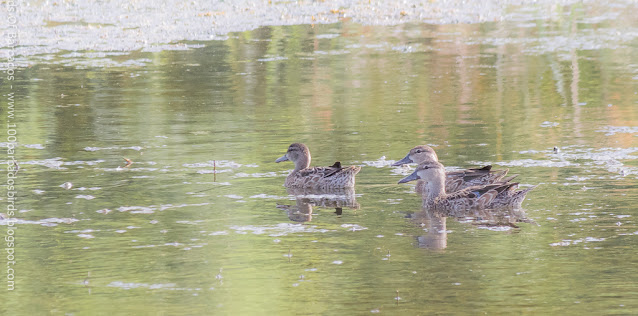What November, the rare birds month, did not show up in quantity, it did with quality, with a new species for Barbados - Squacco Herons (Ardeola ralloides) and two, yet to be confirmed Megas - White-crowned Pigeon (Patagioenas leucocephala) and a Reddish Egret (Egretta rufescens). During the month while we saw a decrease in shorebird migrating we started seeing the arrival of ducks along with the larger herons and egrets.
Over five Great Blue Herons (Ardea Herodias) sightings were made across the island:
- A total of Four birds at two separate locations in the parish of St. Lucy, which included two juveniles;
- One at the Woodbourne Shorebird Refuge (WSR);
- One more was recorded at the Graeme Hall Swamp;
- and yet another was seen at a private location in Christ Church.
Great Egrets (Ardea alba) were more abundant with 14 birds seen at one location in the north.
With ducks, from last month we started to see the arrival of Blue-winged Teals (Spatula discors), our most numerous migratory duck.
- Close to ten at three locations in St. Lucy;
- 21 at Walkers and 3 at Greenland’s Irrigation Pond;
- 7 at Redland, St. George were just a few of the sightings. These numbers are expected to continue to increase into December.
We also saw small numbers of Lesser Scaups (Aythya affinis)
and Ring-necked Ducks (Aythya collaris) at one of the local
ponds but these numbers should also increase in the coming months.
November Rare Bird
Sightings
As we enter the final month of the year, it is expected that ducks will continue to arrive. Attention will also be focused on areas such as The Graeme Hall Swamp, Christ Church and the Turners Hall Woods St. Andrew, the last remaining original woodland on the island, for wintering song birds. Rare Bird Month 2021 is in the bag and yet another new species for the island, let's see if December will give us another one.
Here are the rare
birds seen during the month, highlighted below parish by parish. (* continuing
Birds)
St. Lucy
 |
| Fulvous Whistling-Duck |
- Fulvous Whistling-Duck (Dendrocygna bicolor)* seen with a family of Black-bellied Whistling-Ducks (Dendrocygna autumnalis) at a private location;
- Yellow-billed Cuckoo (Coccyzus americanus)* (6) mostly seen
feeding in a caterpillar infested field;
Glossy Ibis - Glossy Ibis (Plegadis falcinellus)(2)* both Glossys were seen at the start of the month but only one was observed in the latter half.
St. Peter
 |
| Lesser Black-backed Gull |
- Lesser Black-backed Gull (Larus fuscus) one juvenile was seen at the fishing village at Six Men's Bay on the 14th.
St. Andrew
 |
| American Coot with chicks @ Greenland |
- American Coot white-shielded (Fulica Americana)* (13) 6 birds at Walkers Reserve, 7 at Greenland’s Irrigation Pond – one adult, half of a breeding pair whose partner is red-shielded, produced six chicks.
- American Coot – red-shielded (Fulica Americana)* one of a breeding pair at Greenland.
- Fulvous Whistling-Duck (Dendrocygna bicolor) (2) birds seen at Walkers Reserve with Black-bellied Whistling-Ducks
(Dendrocygna autumnalis) making a total of three birds on island during the month.
St. James
- Least Tern (Sternula antillarum) seen by a visitor while catamaraning just off shore;
- Common Tern (Sterna hirundo) seen by a visitor while vacationing at the beautiful Fairmont Royal Pavilion Resort.
ST. Philip
- Pacific Golden-Plover (Pluvialis fulva)* this shorebird was last seen on November 13th
- Least Tern (Sternula antillarum) another resort
sighting by a visiting birder - This time the bird was seen at the luxury Crane Beach Resort.
Christ Church
- Common Tern (Sterna hirundo) (6) on the ice pier at Oistins
- Squacco Herons (Ardeola ralloides) a new species for the island, first seen at the Graeme Hall Swamp on the 26th and lastly on the 28th.
Feel free to contact me, Julian Moore @
100birdsbarbados@gmail.com, John Webster @ barbadosbirds@gmail.com, or Ed
Massiah @ ebmassiah@hotmail.com to report any rare bird sightings, or if you
need assistance identifying a bird, we would be happy to assist.


































